El cabello no solo es un símbolo de estética, sino también un indicador de salud.
El cabello cumple funciones biológicas como regular la temperatura y proteger la piel, aunque también tiene un profundo significado social y emocional para las personas.
La estructura del cabello es fundamental para entender su papel tanto en la protección del cuerpo como en su apariencia. Cada parte del cabello cumple una función específica que contribuye a su resistencia, flexibilidad y aspecto saludable.
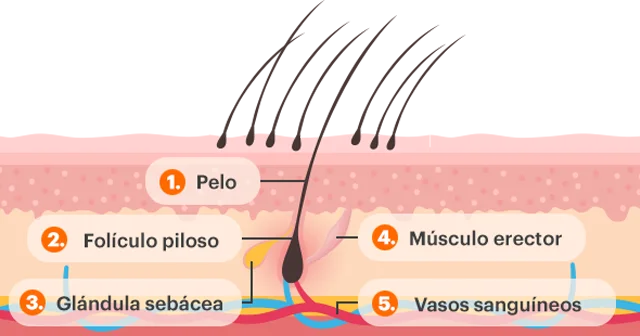
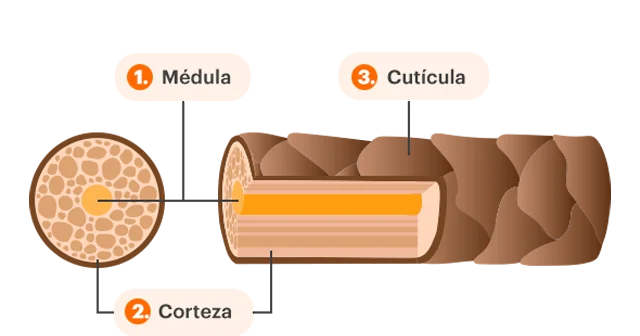
La unidad estructural y funcional del cabello se denomina unidad pilosebácea. Está compuesto por:
1. Pelo
2. Folículo piloso
3. Glándula sebácea
4. Músculo erector del pelo
5. Vasos sanguíneos
El pelo tiene una parte exterior conocida como “tallo” y otra interior (anclada en la piel) denominada “raíz”. Su estructura está formada por 3 capas que contienen gran cantidad de queratina proporcionando al cabello fortaleza y flexibilidad:
1. Médula: la capa más interna.
2. Corteza: la capa intermedia.
3. Cutícula: la capa más externa.
El cabello tiene una actividad cíclica y, por lo tanto, se cae y se renueva periódicamente. No todo el cabello se encuentra en la misma fase, de hecho, la mayor parte se encuentra en la fase de crecimiento. No obstante, cuando existe un desajuste entre la fase de crecimiento y la de caída, hará que percibamos nuestra cabellera más escasa y con menos densidad.
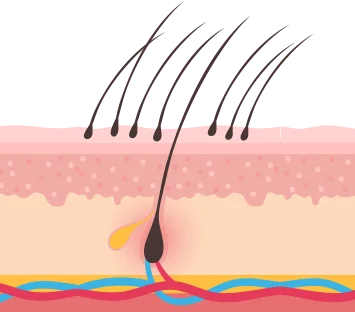
El cabello se encuentra en fase de crecimiento.
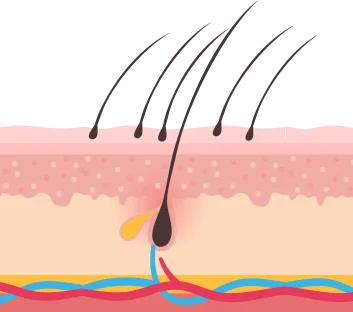
En esta fase el cabello deja de crecer y se mantiene en reposo.
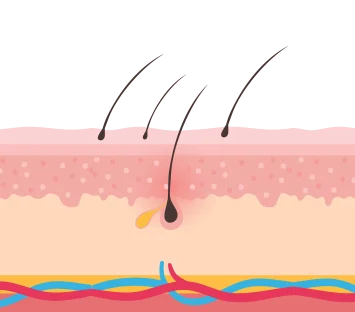
El cabello es empujado hacia afuera y reemplazado por otro nuevo. El proceso se va repitiendo a lo largo de los ciclos.
Notar que tu cabello está perdiendo fuerza es sencillo. Un simple vistazo a tu peine después de cepillarte puede darte la respuesta.
Si observas una cantidad significativa de cabello acumulado en el cepillo o en tu almohada, es una señal de alerta. De hecho, si pierdes más de 150 cabellos al día, podrías estar experimentando una debilidad capilar que necesita atención.
¿Sabías que 1 de cada 3 mujeres sufre caída del cabello?
La alopecia o pérdida de densidad capilar es un problema dermatólogico frecuente. Puede afectar no solo a la apariencia, sino también al autoestima y confianza de quienes la padecen.
Si notas una pérdida significativa de cabello, lo importante es saber que existen soluciones efectivas para recuperar la vitalidad y fuerza de tu cabello.
La caída capilar, que puede tener un impacto significativo en la autoestima y la imagen personal, se puede deber a diversas causas:
Aunque existen muchos tipos de alopecia, los más frecuentes son los siguientes:
Masculina
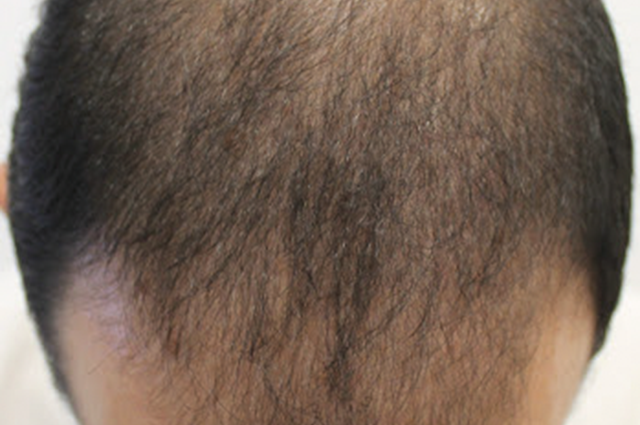
Femenina

Alopecia androgenética (AGA) o calvicie común, la forma más frecuente de alopecia.
La caída del cabello conocida como calvicie común o alopecia androgenética o androgénica es debida a una predisposición genética que intensifica la acción de la hormona testosterona en los folículos pilosos de determinadas áreas.
En España, el 63% de los varones de 50 años presentan alopecia androgenética masculina (MAGA), proporción que aumenta con la edad.
Por otro lado, en nuestro país el 36% de las mujeres padece alopecia androgenética femenina (FAGA), que suele acentuarse a partir de la menopausia, por la pérdida de la protección estrogénica. En un porcentaje alto de casos existen antecedentes familiares, aunque también existen algunos factores que pueden agravar la tendencia a la alopecia, como por ejemplo el déficit de hierro.

El Efluvio telógeno puede aparecer por diferentes causas y se produce una aceleración del paso de los folículos de fase anágena (crecimiento) a fase telógena (caída), con la consiguiente caída del cabello abundante a los 2-4 meses.
Es de duración variable, pero con recuperación total del cabello con el mismo patrón de crecimiento que antes de la alopecia.
Entre las causas se encuentra el estrés, la ansiedad aguda o depresión, los déficits de biotina y zinc, las dietas hipocalóricas, el post-parto, la fiebre prolongada, las grandes cirugías y anestesias, las dermatosis como psoriasis y la toma de determinados medicamentos (selenio, litio, anovulatorios, anticoagulantes, ß-bloqueantes) o la radiación ultravioleta (exposición solar).

El Efluvio anágeno es un tipo de alopecia cuyas causas o estímulos actúan directamente sobre los folículos en fase anágena (crecimiento) causando una caída casi inmediata, o poco tiempo después de la causa.
Normalmente se observa con máxima frecuencia tras quimioterapia o radioterapia (presentándose en el 65% de los pacientes que se someten a tratamientos quimioterápicos por procesos tumorales y su gravedad es generalmente dependiente de la dosis de quimioterapia, y de la variabilidad interindividual) aunque puede tener su origen también en enfermedades (por ejemplo, el hipotiroidismo e hipertiroidismo), a la exposición ocupacional o ambiental a metales pesados y compuestos tóxicos, como talio, plomo, arsénico y mercurio o el uso excesivo de agentes químicos agresivos (el peróxido de hidrógeno y tioglicolatos usados en la peluquería) o debido a desnutrición proteica grave.
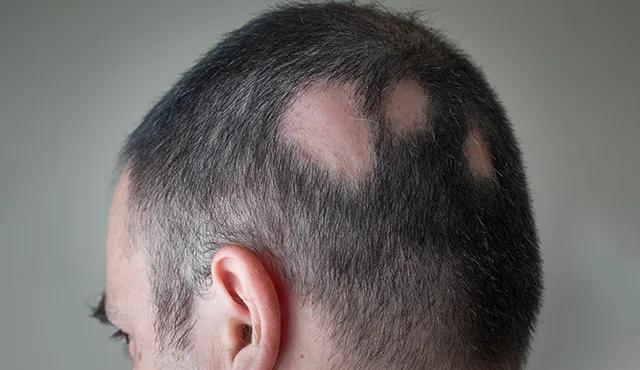
La alopecia areata es una enfermedad benigna autoinmune y autolimitada caracterizada por la presencia de áreas alopécicas o sin cabello. Aparte de la predisposición genética (en un 15-20% de los pacientes existen antecedentes familiares), los factores ambientales parecen ser importantes, por ejemplo, el estrés psicosocial puede ser el desencadenante del brote.
La clínica puede ir desde una placa alopécica limitada única, generalmente en el cuero cabelludo hasta llegar a ser completa, conocida como alopecia total, e incluso de todas las áreas pilosas del cuerpo, la alopecia universal.
La evolución y pronóstico son impredecibles. El pelo puede volver a crecer, y al principio es fino y pigmentado, recuperando su aspecto y color al poco tiempo.
Médicamente es una patología benigna, pero puede tener una gran repercusión negativa en la calidad de vida de los pacientes y en su capacidad funcional.
Para un buen estado de salud del cabello, un complemento alimenticio específico es de gran ayuda, ya que actúa sobre el fondo del problema y activa la autorregulación del propio organismo consiguiendo mantener el cabello en condiciones normales.

Los más adecuados son aquellos que contienen nutrientes esenciales como vitaminas, minerales y oligoelementos que favorecen y restituyen, en casos de déficit o de alto requerimiento nutricional, los elementos necesarios para la formación y crecimiento del cabello.
1. Morganti P, Randazzo S, Bruno C, Effect of gelatin-cystine on hair after a three months treatment (letter). J Soc Cosm Chem 1982;33:95-6.
2. Rushton DH. Nutritional factors and hair loss. Clin Exp Dermatol. 2002;27(5):396-404.
S.P. Coburn, A. Slominski, J.D. Mahuren, et al. Cutaneous metabolism of vitamin B6. J Invest Dermatol, 120 (2003), pp. 292-300.
L. Buzenzinska-Wcislo. Evaluation of vitamin B6 and calcium pantothenate effectiveness on hair growth from clinical and trichographic aspects for treatment of diffuse alopecia in women. Wiad Lek, 54 (2001), pp. 11-18.
Dietary supplement increases anagen hair rate in women with telogen effluvium: results of a double-blind placebo-controlled trial. Therapy, 4 (2007), pp. 59-65.
Galmés JL. Nutrientes y metabolismo del pelo. Piel (Barc). 2023;38(3): 204-7.
D.H. Rushton, M.I. Norris, R. Dover, et al. Causes of hair loss and the developments in hair rejuvenation. Int J Comet Sci, 24 (2002), pp. 17-23.
Water-soluble vitamins. En: Recommended Dietary Allowances: 10th edition. Subcommittee on the Tenth Edition of the RDAs. Food and Nutrition Board. Commission on Life Sciences. National Research Council. Washington, D.C.: National Academy Press; 1989. p.115-73.
Galmés JL. Nutrientes y metabolismo del pelo. Piel (Barc). 2023;38(3): 204-7.
2. Rushton DH. Nutritional factors and hair loss. Clin Exp Dermatol. 2002;27(5):396-404.
* Kantor J, Kessler LJ, Brooks DG, et al. Decreased serum ferritin is associated with alopecia in women. J Invest Dermatol. 2003;121(5):985-8.
* Almohanna HM, Ahmed AA, Tsatalis JP, et al. The role of vitamins and minerals in hair loss: a review. Dermatol Ther (Heidelb). 2019;9(1):51-70.
* Deloche C, Bastien P, Chadoutaud S, et al. Low iron stores: a risk factor for excessive hair loss in non-menopausal women. Eur J Dermatol. 2007;17(6):507-12.
* Fiedler VC, Gray AC. Diffuse alopecia: telogen hair loss. In: Olsen EA, editor. Disorders of hair growth: diagnosis and treatment. 2nd ed. New York: McGraw-Hill; 2003.
* De Viragh. Alopecia ferropénica. En: Camacho FM y Tosti A, eds. Tricología. Enfermedades del folículo pilosebáceo. 3a Edición, Volumen II, págs. 709-717. Madrid, Aula Médica, 2013.
* Treister-Goltzman Y, Yarza S, Peleg R. Iron deficiency and nonscarring alopecia in women: systematic review and meta-analysis. Skin Appendage Disord. 2022;8(2):83-92. 1.
* E.L. Guo, R. Katta. Diet and hair loss: effects of nutrient deficiency and supplement use. Dermatol Pract Concept, 7 (2017), pp. 1-10.
* Trost LB, Bergfeld WF, Calogeras E. The diagnosis and treatment of iron deficiency and its potential relationship to hair loss. J Am Acad Dermatol. 2006;54(5):824-44.
* Galmés JL. Nutrientes y metabolismo del pelo. Piel (Barc). 2023;38(3): 204-7.
Patel DP, Swink SM, Castelo-Soccio L. A review of the use of biotin for hair loss. Skin Appendage Disord. 2017;3(3):166-9. 21.
Trüeb RM. Serum Biotin Levels in Women Complaining of Hair Loss. Int J Trichology. 2016;8(2):73-7.
Erlemann GA. Vitamine in der kosmetik. Seifen Öle Fette Wachse 1984; 110:181-6.
J.W.S. Zempleni, T. Koroshi.
Biotin. Present knowledge in nutrition. 10th ed., Wriley-Blackwell, (2012), pp. 359-374.
F.M. El-Esawy, M.S. Hussein, Mansour A. Ibrahim. Serum biotin and zinc in male androgenetic alopecia. J Cosmet Dermatol, 18 (2019), pp. 1546-1549.
J. Zempleni, Y.I. Hassan, S.S. Wijeratne. Biotin and biotinidase deficiency. Expert Rev Endocrinol Metab, 3 (2008), pp. 715-724.
Galmés JL. Nutrientes y metabolismo del pelo. Piel (Barc). 2023;38(3): 204-7.
K. Aiempanakit, S. Jandee, K. Chiratikarnwong, et al. Low plasma zinc levels in androgenetic alopecia. Indian J Dermatol Venereol Leprol, 83 (2017), pp. 741.
T. Karashima, D. Tsuruta, T. Hamada, et al. Oral zinc therapy for zinc deficiency-related telogen effluvium. Dermatol Ther, 25 (2012), pp. 210-213.
H. Park, C.W. Kim, S.S. Kim, et al. The therapeutic effect and the changed serum zinc level after zinc supplementation in alopecia areata patients who had a low serum zinc level. Ann Dermatol, 21 (2009), pp. 142-146.
Demetree JW, Safer LF, Artis WM. The effect of zinc on the sebum secretion rate. Acta Derm Venereol. 1980;60:166-9.
Leake A, Chisholm GD, Habib FK. The effect of zinc on the 5α-reduction of testosterone by the hyperplastic human prostate gland. J Steroid Biochem. 1984;20:651-5.
Stamatiadis D, Bulteau-Portois MC, Mowszowicz I. Inhibition of 5α-reductase activity in human skin by zinc and azelaic acid. Br J Dermatol. 1988;119:627-32.
P. Ozturk, E. Kurutas, A. Ataseven, et al. BMI and levels of zinc, copper in hair, serum and urine of Turkish male patients with androgenetic alopecia. J Trace Elem Med Biol, 28 (2014), pp. 266-270.
F.M. El-Esawy, M.S. Hussein, Mansour A. Ibrahim. Serum biotin and zinc in male androgenetic alopecia. J Cosmet Dermatol, 18 (2019), pp. 1546-1549.
Galmés JL. Nutrientes y metabolismo del pelo. Piel (Barc). 2023;38(3): 204-7.
1. Morganti P, Randazzo S, Bruno C, Effect of gelatin-cystine on hair after a three months treatment (letter). J Soc Cosm Chem 1982;33:95-6.
*Frati C, Cavalieri R, Giardini O, et al. Terapia dell’area celsi con cistina. Chron Derm 1979;10:45-50.
*Riegel K, Hengl T, Krischok S, et al. L-Cystine-containing hair-growth formulation supports protection, viability, and proliferation of keratinocytes. Clin Cosmet Investig Dermatol. 2020;13:499-510.
*De Padova MP, Tosti A, Veronesi S. Gelatin-cystine in seborrheic alopecia. J Appl Cosmetol. 1986;4:55-60.
*S. Segal. The cystine. Science, 197 (1977), pp. 169.
*Galmés JL. Nutrientes y metabolismo del pelo. Piel (Barc). 2023;38(3): 204-7.